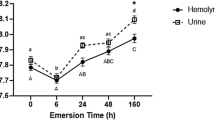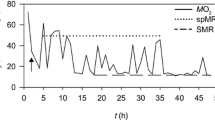Summary
Net sodium flux (J net), sodium influx (J in), and sodium efflux (J out) were measured in two sunfish,Enneacanthus obesus (acid-tolerant) andLepomis gibbosus (less acid-tolerant), during 24 h exposure to soft water of pH's 4.0 and 3.5.E. obesus exhibited a mild transitory disturbance at both pH's caused by inhibitedJ in and slightly stimulatedJ out. Body and plasma ion concentrations ofE. obesus were measured weekly during exposures for 5 weeks to acidified artificial soft water (ASW). Body sodium concentration declined 30% during 2 weeks exposure to pH 3.5 but no further during the next three weeks. Exposure to pH 4.0 had no effect on body sodium concentration during the entire 5 weeks. Plasma sodium concentration declined 15% over a 3 week period at pH 3.5; there was no further change in the next two weeks. Plasma potassium concentrations, which were measured after 4 and 5 weeks at pH's 5.8 and 3.5 in ASW, were not significantly different. In a separate two week long experiment, plasma sodium concentration ofE. obesus in ASW was correlated with pH between pH's 3.5 and 7.5. This effect was mainly due to increases above pretreatment levels at pH 4.5 and above. Increased ambient sodium and calcium concentrations had no effect on body sodium concentration ofE. obesus at pH 5.8, but mitigated the effects of exposure to pH 3.5. Increased calcium concentrations up to 25 μM at pH 3.5 increased body sodium concentration, but higher concentrations had no additional effect. Body potassium concentration and body water concentration ofE. obesus were linearly related to body sodium concentration under a wide variety of external conditions. This suggests the presence of a mechanism by whichE. obesus regulates plasma sodium levels and body fluid compartments in response to sodium loss. In contrast toE. obesus, L. gibbosus showed larger sodium losses at low pH resulting from greater acceleration ofJ out; those exposed at pH 3.5 died in less than 12 h.L. gibbosus also had reduced body and plasma sodium concentrations at pH 4.5 and below; those at pH 4.0 were the lowest. Body potassium concentration ofL. gibbosus was reduced in those fish exposed to pH 4.0 and below, but body water was increased. Thus there are striking differences in the ability to regulate ion and water balance at low pH between an acid-tolerant specialist (E. obesus) and a less acid-tolerant generalist (L. gibbosus).
Similar content being viewed by others
Abbreviations
- ASW :
-
artificial soft water
- WBM :
-
wet body mass
- DBM :
-
dry body mass
References
Dunson WA, Swarts F, Silvestri M (1977) Exceptional tolerance to low pH of some tropical blackwater fish. J Exp Zool 201:157–162
Evans DH (1979) Fish. In: Maloiy GMO (ed) Comparative physiology of osmoregulation in animals, vol 1. Academic Press, London, pp 305–390
Freda J, Dunson WA (1984) Sodium balance of amphibian larvae exposed to low environmental pH. Physiol Zool 57:435–443
Freda J, Dunson WA (1985) Field and laboratory studies of ion balance and growth rates of ranid tadpoles chronically exposed to low pH. Copeia 1985:415–423
Fugelli K, Vislie T (1980) Physiological responses to acid water in fish. 1. Effects from changes in plasma osmolality and ion concentration on heart ventricle water content and intracellular concentrations of K+ and taurine in the brown trout (Salmo trutta L.). In: Drablos D, Tollan A (eds) Ecological impact of acid precipitation, March 11–14, 1980. Sandefjord, Norway, pp 346–347.
Graham JH, Hastings RW (1984) Distributional patterns of sunfishes on the New Jersey coastal plain. Environ Biol Fishes 10:137–148
Grande M, Muniz I, Andersen S (1978) Relative tolerance of some salmonids to acid water. Int Verein Theor Ang Limn Verh 20:2076–2084
Hastings RW (1979) Fish of the Pine Barrens. In: Forman RTT (ed) Pine Barrens: Ecosystem and landscape. Academic Press, New York, pp 489–504
Krout RT, Dunson WA (1985) Stimulation of sodium efflux in air-breathing fish exposed to low pH. Comp Biochem Physiol 82c:49–53
Lauren DJ, McDonald DG (1985) Effects of copper on branchial ionoregulation in the rainbow trout,Salmo gairdneri Richardson: Modulation by water hardness and pH. J Comp Physiol B 155:635–644
Leivestad H, Muniz IP (1976) Fish kill at low pH in a Norwegian river. Nature 259:391–392
Mashiko K (1940) Limnological study of Lake Osoresan-ko. A remarkable acidotrophic lake in Japan. Sci Rep Tohoku Imperial Univ. Fourth series. Biology 15:331–356
Mashiko K, Jozuka K, Asakura K (1973) Different type of chloride cells in the gills ofTribolodon hakonensis from Lake Osoresan-ko. Annu Rep Noto Mar Lab 13:33–37
McDonald DG (1983) The effects of H+ upon the gills of freshwater fish. Can J Zool 61:691–703
McDonald DG, Rogano MS (1986) Ion regulation by the rainbow trout,Salmo gairdneri, in ion poor water. Physiol Zool 59:318–331
McDonald DG, Wood CM (1981) Branchial and renal acid and ion fluxes in the rainbow trout,Salmo gairdneri, at low environmental pH. J Exp Biol 93:101–108
McDonald DG, Hobe H, Wood CM (1980) The influence of calcium on the physiological responses of the rainbow trout,Salmo gairdneri, to low environmental pH. J Exp Biol 88:109–131
McDonald DG, Walker RL, Wilkes RLK (1983) The interaction of calcium and low pH on the physiology of the rainbow troutSalmo gairdneri. 2. Branchial ionoregulatory mechanisms. J Exp Biol 102:141–155
McWilliams PG (1980) Acclimation to an acid medium in the brown troutSalmo trutta. J Exp Biol 88:269–280
McWilliams PG (1983) An investigation of the loss of bound calcium from the gills of the brown trout,Salmo trutta, in acid media. Comp Biochem Physiol 74A:107–116
McWilliams PG, Potts WTW (1978) The effects of pH and calcium concentrations on gill potentials in the brown trout,Salmo trutta. J Comp Physiol 126:277–286
Menendez R (1976) Chronic effects of reduced pH on brook trout (Salvelinus fontinalis). J Fish Res Board Can 33:118–123
Milligan CL, Wood CM (1982) Disturbances in haematology, fluid volume distribution and circulatory function associated with low environmental pH in the rainbow trout,Salmo gairdneri. J Exp Biol 99:397–415
Packer RK, Dunson WA (1970) Effects of low environmental pH on blood pH and sodium balance of brook trout. J Exp Zool 174:65–72
Packer RK, Dunson WA (1972) Anoxia and sodium loss associated with death of brook trout at low pH. Comp Biochem Physiol 41A:17–26
Rahel FJ (1984) Factors structuring fish assemblages along a bog lake successional gradient. Ecology 65:1276–1289
Robertson JS (1983) Compartmental distribution of radiotracers. CRC Press, Boca Raton, Florida, pp 12–27
Robinson GD, Dunson WA, Wright JE, Mamolito GE (1976) Differences in low pH tolerance among strains of brook trout,Salvelinus fontinalis. J Fish Biol 8:5–17
Rubin D (1985) Effects of pH on sex ratio in cichlids and a poecilliid (Teleostei). Copeia 1985:233–235
Ruby SM, Aczel J, Craig GR (1977) The effects of depressed pH on oogenesis in flagfishJordanella floridae. Water Res 11:757–762
Shearer KD (1984) Changes in elemental composition of hatchery-reared rainbow trout,Salvelinus fontinalis, associated with growth and reproduction. Can J Fish Aquat Sci 41:1592–1600
Sokal RR, Rohlf FJ (1969) Biometry. Freeman, San Francisco, p 776
Swarts FA, Dunson WA, Wright JE (1978) Genetic and environmental factors involved in increased resistance of brook trout to sulphuric acid solutions and mine acid polluted waters. Trans Am Fish Soc 107:651–677
Sweeney FF (1972) The systematics and distribution of the centrarchid fish tribe Enneacanthini. Ph.D. Thesis, Boston University, Boston, Massachusetts, p 201
Author information
Authors and Affiliations
Rights and permissions
About this article
Cite this article
Gonzalez, R.J., Dunson, W.A. Adaptations of sodium balance to low pH in a sunfish (Enneacanthus obesus) from naturally acidic waters. J Comp Physiol B 157, 555–566 (1987). https://doi.org/10.1007/BF00700975
Accepted:
Issue Date:
DOI: https://doi.org/10.1007/BF00700975




